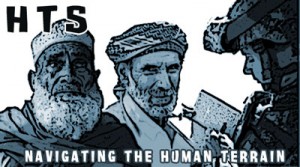Pentagon distributed much of the funding to two large defense firms that became the HTS’s principal contractors: BAE Systems and CGI Federal.
HTS supporters frequently claimed that the program would increase cultural understanding between US forces and Iraqis and Afghans–and therefore reduce American and civilian casualties. The program’s leaders insisted that embedded social scientists were delivering sociocultural knowledge to commanders, but the reality was more complex. HTS personnel conducted a range of activities including data collection, intelligence gathering, and psychological operations. In at least one case, an HTS employee supported interrogations in Afghanistan (Weinberger 2011).
The program also served a more insidious function: It became a propaganda tool for convincing the American public–especially those with liberal tendencies–that the US-led occupations of Iraq and Afghanistan were benevolent missions in which smart, fresh-faced young college graduates were playing a role. It appeared to demonstrate how US forces were engaged in a kinder, gentler form of occupation. Department of Defense photos portrayed HTS personnel sitting on rugs while drinking tea with Afghan elders, or distributing sweets to euphoric Iraqi children. Here was a war that Americans could feel good about fighting.
When HTS was first announced in late 2006, I followed its development with concern. Along with many other anthropologists, I opposed the program because of the potential harm it might bring to Iraqi and Afghan civilians–and to future generations of social scientists who might be accused of being spies when conducting research abroad.
Apart from anthropologists, HTS had other critics. A small but vocal group of military officers publicly criticized the program, noting that it was “undermining sustainable military cultural competence” (Connable 2009) and that in practice, “the effectiveness of the HTTs [human terrain teams] was dubious at best” (Gentile 2013). Yet despite these criticisms, the program grew exponentially. At its peak in 2010, HTS employed more than 500 people ranging from career academics with PhDs to retired Special Forces personnel. Over the next few years, more than 30 “human terrain teams” (HTTs) were deployed in Iraq and Afghanistan, and the program’s annual budget exploded to more than $150 million.

